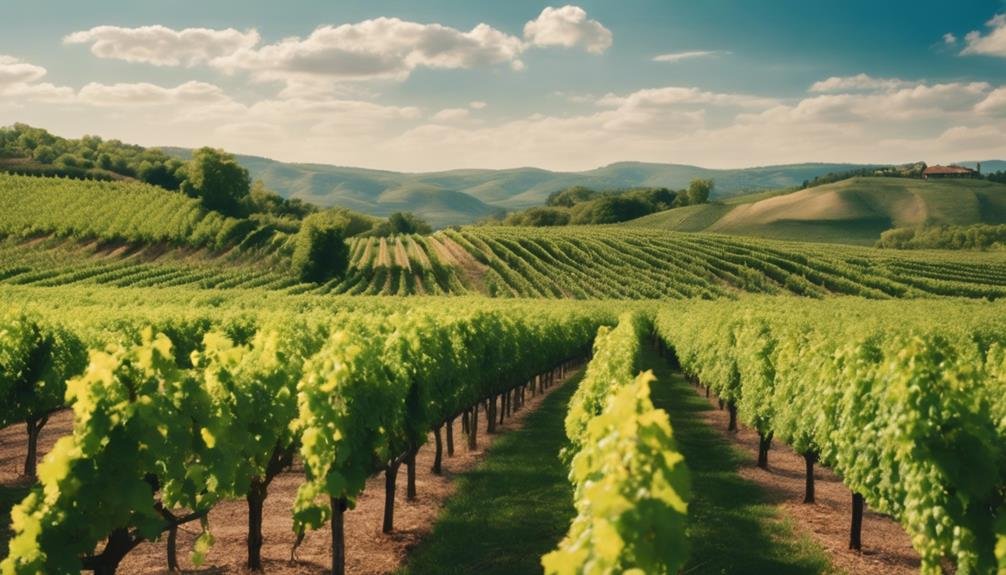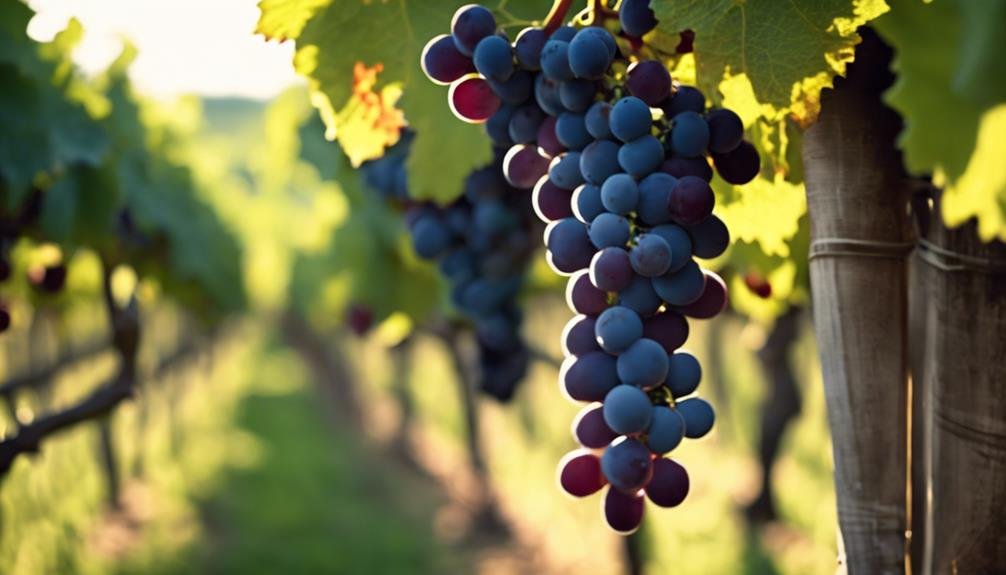Muscadine wine is a standout in winemaking, packed with potent compounds like polyphenols, resveratrol, and ellagic acid, offering unique flavors and impressive health benefits. Varieties like Scuppernong, Carlos, Ison, Noble, and Higgins provide distinct tastes ranging from ripe banana to cranberry. Cultivating Muscadine vines requires precise pruning and trellis selection for peak growth. Tasting Muscadine wines reveals a medium acidity and body, ranging from sweet to dry, complementing various dishes. Noteworthy, Muscadine grapes stand out for producing ellagic acid, and their genetics differ from Vitis vinifera. Explore the world of Muscadine wines for a delightful journey of flavors and benefits.
Health Benefits of Muscadine Wine
Muscadine wine, renowned for its unique health properties, offers a plethora of benefits that make it stand out as a superfruit in the world of winemaking. The nutritional advantages of muscadine wine stem from its high levels of polyphenols, resveratrol, and ellagic acid.
Ellagic acid, specifically, targets conditions related to obesity, making muscadine wine a valuable addition to a wellness-focused lifestyle. Research suggests that muscadine wine is the only wine grape that produces ellagic acid, further solidifying its status as a superfruit.
Additionally, studies show promising results in reducing fatty liver, showcasing the wellness benefits associated with consuming muscadine wine. With its rich nutritional profile and potential health-promoting properties, muscadine wine truly stands out as a superfruit in the world of winemaking.
Muscadine Grape Varieties for Winemaking
Which grape varieties derived from the Muscadine species are most commonly utilized in winemaking processes?
Muscadine grapes, known for their unique flavor profiles and robust characteristics, are often harvested between August and October. Varieties like Scuppernong, Carlos, Ison, Noble, and Higgins are popular choices due to their distinct taste profiles.
Muscadine grapes offer a range of flavors, from ripe banana and bruised apple to lime peel, cranberry, and even hints of rubber cement. The harvest timing is essential as these grapes ripen independently and require hand-harvesting.
Their sweetness levels are typically lower than Vitis vinifera grapes, leading winemakers to sometimes chaptalize the must. Overall, Muscadine grape varieties provide winemakers with a diverse range of options to create wines with unique and flavorful characteristics.
Muscadine Vine Cultivation Tips

Cultivating Muscadine vines successfully requires careful attention to specific growth conditions and practices that optimize grape quality and yield. Pruning techniques play a vital role in vine management, promoting airflow, sunlight exposure, and the production of high-quality fruit. Regular pruning, especially during the dormant season, helps control vine growth and fruit production.
Additionally, selecting the right trellis design is essential for supporting the vigorous growth of Muscadine vines. A well-designed trellis system provides structural support, facilitates vine training, and aids in optimizing grape ripening. By implementing proper pruning techniques and an efficient trellis design, Muscadine growers can enhance grape quality, increase yields, and ultimately produce exceptional wines from these unique superfruits.
Muscadine Wine Tasting Experience
When exploring the world of wine, experiencing the unique tasting notes of Muscadine wine offers a distinctive journey for the palate. Muscadine wines are typically made in a sweet style, with primary flavors including ripe banana, bruised apple, lime peel, cranberry, and even hints of rubber cement. The intense aromas of ripe bananas combined with subtle notes of lime or cranberry create a memorable tasting experience. These wines range from dry to sweet, offering a medium body and acidity that pairs well with a variety of dishes. To fully appreciate Muscadine wine, try sampling it at different temperatures to reveal its full flavor profiles. Here is a table to help you understand the tasting notes better:
| Flavor Profiles | Pairings | Tasting Techniques |
|---|---|---|
| Ripe banana, bruised apple | Soft cheeses, spicy dishes | Experiment with different temperatures |
| Lime peel, cranberry | Grilled chicken, seafood | Swirl the wine in the glass to aerate |
Interesting Facts About Muscadine Wine

Surprisingly, Muscadine wine is the only wine grape variety that produces ellagic acid, a compound known for its health benefits targeting conditions related to obesity.
- Muscadine genetics reveal it has 2 more chromosomes than Vitis vinifera.
- Unique flavors in Muscadine wine include ripe banana, bruised apple, lime peel, and cranberry.
- Muscadine grapes ripen independently, requiring hand-harvesting for best timing.
- The sweetness level of Muscadine is typically lower than Vitis vinifera, often necessitating chaptalization to reach desired taste profiles.
Frequently Asked Questions
How Do You Pronounce "Muscadine" Correctly?
The correct pronunciation of "muscadine" is "MUSS-kuh-dyne." Regional variations exist, with some accents emphasizing different syllables. The term originates from the Muscogee language. Common mispronunciations include "muss-kuh-DEEN" or "muhs-kuh-DINE." The phonetic breakdown is MUSS-kuh-dyne.
Can Muscadine Grapes Be Used to Make Non-Alcoholic Products?
The versatile Muscadine grapes are not limited to winemaking; they can be used to create flavorful non-alcoholic products. Muscadine grape juice offers a invigorating taste, while Muscadine grape jelly provides a delicious spread rich in the unique essence of these grapes.
Are Muscadine Vines Prone to Specific Diseases or Pests?
Muscadine vines exhibit natural disease resistance, requiring minimal intervention for pest control. Successful vineyard management practices, such as regular pruning and proper canopy management, contribute to their resilience against common vineyard diseases and pests.
What Is the Carbon Footprint of Muscadine Wine Production?
The carbon footprint of muscadine wine production can vary depending on vineyard practices, transportation methods, and energy sources. Sustainability initiatives, such as organic farming, renewable energy use, and efficient packaging, aim to reduce environmental impact.
Can Muscadine Wine Be Aged in Oak Barrels for Flavor Enhancement?
Muscadine wine can be aged in oak barrels to enhance its flavor profile. This process imparts complexities like vanilla, spice, and toast notes. Aging allows the wine to develop and integrate flavors, creating a smoother and more nuanced final product.
Conclusion
To sum up, muscadine wine is a true gem in the world of winemaking, offering not only a unique and flavorful experience but also potential health benefits. Like a hidden treasure waiting to be discovered, muscadine grapes bring a touch of Southern charm and complexity to the wine world.
So, raise a glass of muscadine wine and savor the richness of this superfruit, a true delight for the senses. Cheers to the beauty and bounty of muscadine wine!
